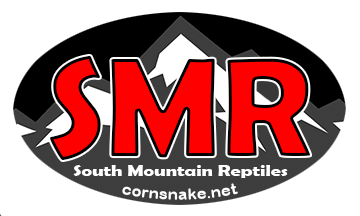Story of the Terrazzo Corn Snake Mutation
Share

Most Commonly Used Name: Terrazzo
Mode of Genetic Inheritance: Recessive
Morph Type: Recessive to wild-type
Eye Color: Black pupil & body ground-colored iris.
It was awkward (and confusing) when just a few months after this name re-assignment when Bill and Kathy Loves’ Book (Corn Snakes – The Comprehensive Owner’s Guide) was released, it featured a picture identifying a GRANITE CORN, but of course, that tan corn snake looked nothing like the NEW Granites (formerly Anery Bloodreds) that are black and gray.
Jeff Galewood re-named the original Granite corns Terrazzos as he was the primary market producer of this beautiful mutation at that time. I called this the second “striped-type allele” because it IS the second one if you don’t count the striped version of Motley (since it is on the same locus with Motley) and Tesseras.

Several breeders (myself included) have performed breeding trials to verify that Terrazzos is not allelic to other gene mutations. As of the early 2000's, evidence points to Terrazzos being a unique single recessive mutation. I bred a classic Striped Corn mutant to a Key Corn Het for Terrazzo and it yielded no mutant corns out of 21 fertile embryos.

Terrazzos are a lean race of corns, some reaching the length of typical mainland corns, but usually smaller girth than most common corns. The absence of black on most Keys corns is primarily the result of captive selective-breeding. In the wild, it’s common to see some black on these beautiful insular corns.
Note: Not all Key Corns are devoid of black. Many have black in their pattern AND on their bellies. I point this out because we don’t yet know if the lack of melanin on the belly of Terrazzos is a feature of the mutation or of the respective race of Key Corns from which it derived.


What to expect:
Hatchling Terrazzos are dark-colored when compared to their adult counterparts, and at a glance, you would not suspect them to mature to look so much like a Hypo mutant. Except for pattern, some adults have colors identical to the most HYPOmelanistic mutants (virtually devoid of black). I have bred Keys Corns to Hypo mutants and reproduced Hypo mutants, but that does not always happen. It would be totally understandable that someone thought the Keys Corn they had was a Hypo mutant and therefore bred it to a Hypo mutant – thereby infusing the Hypo mutation into that respective family line.

Upon first seeing a Terrazzo, you would understandably think you were seeing a classic Striped or Motley mutant. The stripes of Terrazzos are very similar to those of the classic Striped mutants, but there are obvious distinctions. The dorsal striping on most of them gradually fades around half-way to the tail.
There have not been enough Terrazzos produced to declare a “typical” pattern for them, but so far, the rare and somewhat elusive target for this snake is a totally patternless corn. Some of the first Terrazzos had very little or NO pattern, other than an over-wash of speckles – looking as though the pattern had been shattered to fragments (giving the snake the appearance of GRANITE stone).
